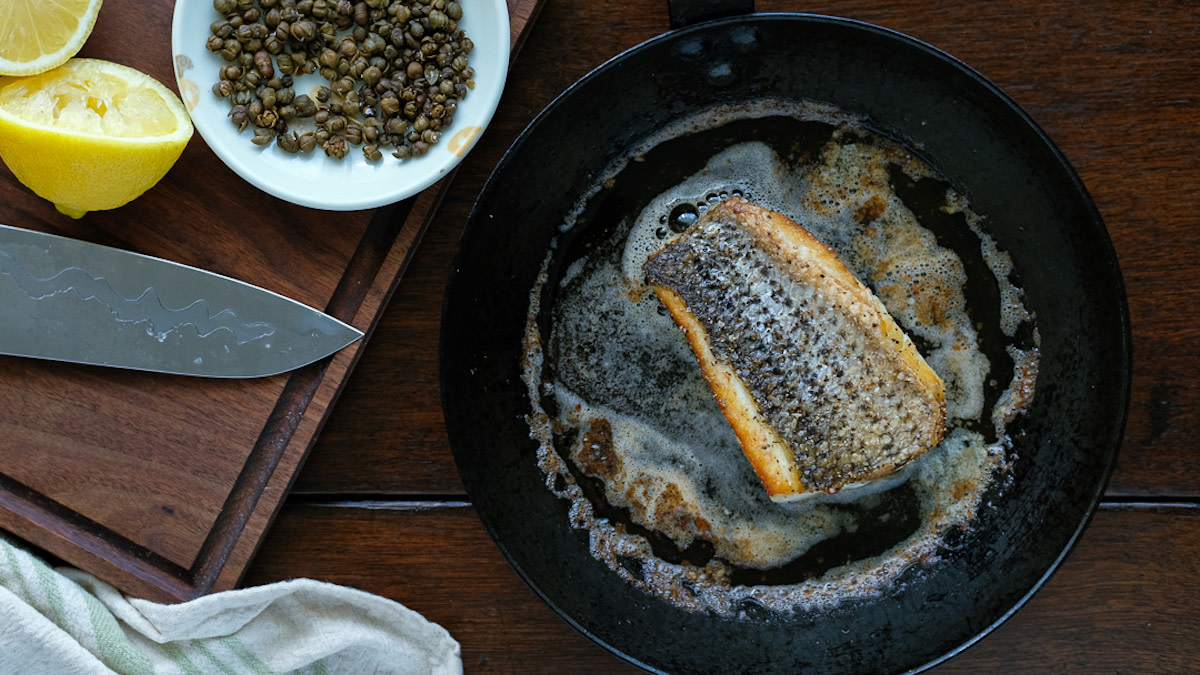
If you want a golden-brown crust on a thick fillet of fish, pan roasting is the best way to achieve it. Pan roasting fish is a simple technique. As the name implies, it combines two cooking methods: pan searing and oven roasting. By combining these two techniques you can create an evenly cooked protein with superior texture and complex flavor.
The basic idea is to first sear the fish in a pan and then move the pan with the fish into a preheated oven. This combination of direct heat from pan searing and indirect heat from baking gives you all the benefits of direct heat cooking—crispy skin, browned exterior, and developed flavor—as well as all the control of indirect heat, which results in even cooking and moisture retention.
This method works with all fish, but the benefits are most noticeable with thicker fillets, whole fish, or skin-on fillets. With small, thin fillets like panfish, perch, or small flounder, the fillet will cook through in the pan—no need for the oven. However, when you’re cooking thick fillets like striped bass, cobia, or wahoo, if you sear only in the pan, the result is unevenly cooked meat—the exterior portion of the fish will cook well beyond the desired temperature before the interior is finished. But just baking the fillet results in bland, texture-less meat, and skin-on fillets will rarely get crispy with only indirect heat.
With pan roasting, the direct heat from the sear browns the exterior into a toasty crispness, and everyone knows properly browned foods taste best. Proteins that aren’t browned lack depth of flavor and texture—imagine a steamed steak or boiled meat. A quick sear achieves both the flavor and textural depth of a properly cooked piece of meat, and the time in the oven allows the center of the fillet to cook evenly.
Before I pan roast fish (or any protein for that matter), I preheat the oven to 400°F. Once the oven is at the desired temperature, I heat up a heavy-bottomed pan over medium-high heat. Next, I season the fish, add oil to the pan to keep the fish from sticking, and add the fish, skin side down first. Cook for one to three minutes maintaining the medium-high heat or until the side on the fillet is golden brown.
When seared correctly, the fish should move easily in the pan and not stick. Flip the fish and continue to cook for another minute, then transfer it to the center of the preheated oven. The second side will have more time directly on the pan while in the oven where it will continue to brown, so there is no need to get it as dark as the first side.
The amount of time in the oven will depend on the thickness and density of the fish as well as your desired internal temperature. Thin fillets will only take two to five minutes, medium fillets four to eight minutes, and thick fillets six to 12 minutes. In the same vein, delicate fish like perch and flounder will take less time to cook, unlike dense fish such as monkfish or swordfish.
A good practice is to check the temperature of the fish with a meat thermometer and gauge how much the temperature has climbed after a minute or two in the oven. Like all proteins (but even more so with fish) it’s better to be underdone than overdone. You can always keep cooking fish if it’s not finished, but there's no coming back once it’s overcooked. Once you get the hang of this process, you’ll be able to pan roast fish without taking a temperature. Remember that every oven is different and most of them are not calibrated, so use these times as guidelines. If using a convection oven, the cook time should be reduced.
In addition to the flavor and texture benefits of pan roasting, it also allows you to add ingredients to the pan as the fish is finishing in the oven. Add extra butter, tomatoes, or lemon before popping in the oven or add them midway through. This is perfect for when you want to lightly cook or warm up an ingredient that pairs with the fish without using a second pan. The addition of butter or other fat also acts as a thermal medium, aiding in the even cooking of the fish as well as basting it in flavor. Once the fish is out of the pan, you can add wine or lemon juice to the drippings and reduce it a bit to make for a quick and easy pan sauce.
Pan roasting fish is easy, consistent, and convenient. It might be the all-around best way to cook fish at home—almost all the fish I cook that isn’t fried or grilled gets treated with this combination of heat. This technique performs beyond fish as well; venison, waterfowl, and upland game birds can all be pan roasted to perfection.







